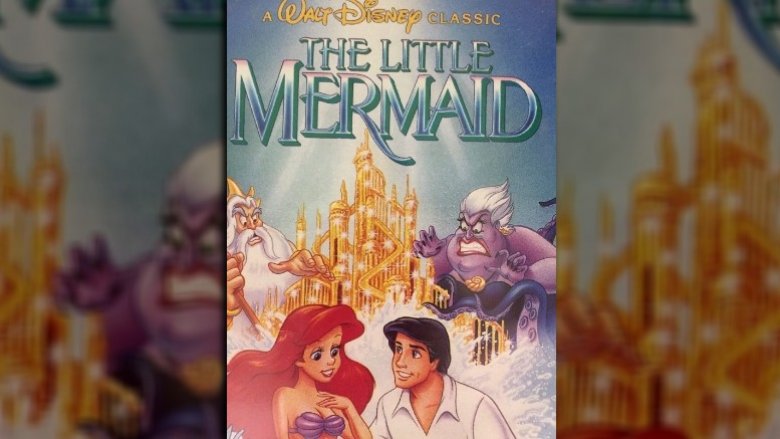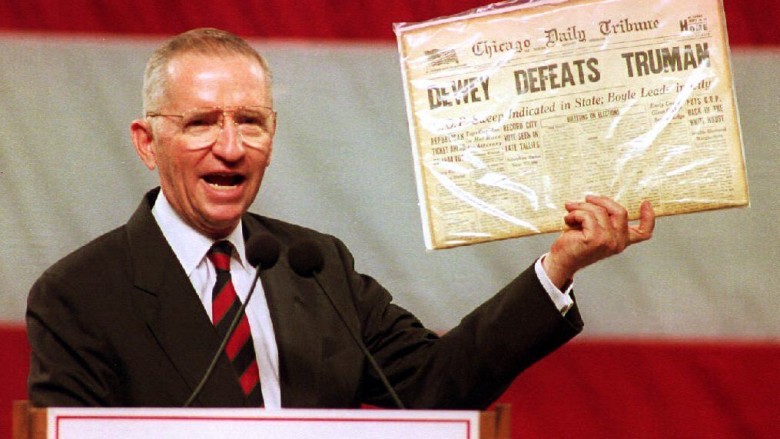False Facts About The '90s You Always Thought Were True
We take it for granted from our cushy, internet-ready spot in the 21st century, but it used to be a lot more difficult to fact-check specious crap you heard on the streets. The '90s were perhaps the final decade to deal with this, which means certain myths and legends about these dark times lingered un-debunked for so long, we've long since just accepted them as fact. So gather around, young Millennials and "Digital Natives" (whoever you're supposed to be). Let's set the record straight, shall we?
Al Gore said he invented the Internet
There's no need to debunk whether or not Al Gore actually invented the internet, because we all know Bill Gates and Steve Jobs invented it in 1984 at Area 51, along with Hypercolor shirts, the robot girl from Small Wonder, and those flip-flops you can open a beer with (it was a busy weekend). But what does need clearing up is the notion that Gore, in an epic, self-congratulatory brain fart, actually said he "invented" the thing you're using to read this right now. No, what Gore actually said in 1999 was "I took the initiative in creating the Internet," which out of context, doesn't sound a whole lot different.
But it's disingenuous—not to mention hacky—to keep spreading the "invented" lie, as Louisiana Governor Bobby Jindal "jokingly" did in 2013. It's actually clear from the context of his remarks that Gore meant, in his clumsy-yet-soporific way, he helped foster its development, which is absolutely true. His legislative contributions helped fund the creation of the first widely-used browser, and ensured greater public access to the web in the back half of the '90s, including getting it into more schools and libraries. He's enshrined in the Internet Hall of Fame for his work, for Bing's sake, presumably next to The Dress, a wax statue of Tay Zonday, and a rare LaserDisc copy of You've Got Mail. So give the poor guy a break.
Nirvana killed hair metal overnight
The almost-universally accepted notion that '80s hair-metal was there on Monday, Nirvana's Nevermind arrived on Tuesday, and hair-metal was no more by Wednesday is patently untrue. Yes, 1991's Nevermind did usher in a decade-long wave of dismal soundalikes (Marcy Playground, what's good?), washing glam acts like Poison, Cinderella, and Warrant off of the charts. But it's not like the monoculture just accepted their new grunge overlords overnight. Exhibit A: the double-platinum FireHouse, a glam act who actually beat Nirvana and Alice in Chains for the 1992 "Favorite Heavy Metal/Hard Rock New Artist" American Music Award. FireHouse, a band that isn't even the top result in a Google search for FireHouse, won by popular vote against two grunge titans.
It's also true that Nevermind spent two weeks as the number one album in the country in 1992, but you know what else did? The Wayne's World soundtrack, featuring Cinderella, BulletBoys (ex-Ratt), Alice Cooper (feat. Nikki Sixx) and famously, glam rock gods Queen. How about 1993? The glam-meets-Broadway stylings of Meat Loaf's "I'd Do Anything For Love (But I Won't Do That)" was the only rock song to top the Billboard Hot 100 that year.
By 1994, three years after it began, the cleansing was finally complete: Nirvana, Stone Temple Pilots, Soundgarden, and Alice in Chains all had number one albums in the Billboard 200, and glam metal had none. By the end of the decade, turgid, half-baked Nirvana clones ruled the airwaves, a reminder to be careful what you wish for ("Cumbersome," how do you do?).
Ecstasy drains your spinal fluid
Eminem took a sarcastic swipe at '90s rave culture by enjoining kids to "let the X destroy your spinal cord/So it's not a straight line no more" in "Drug Ballad," a track on his 2000 album The Marshall Mathers LP. Researchers say this "persistent myth" about Ecstasy dates back to the early '90s, but like a pacifier necklace you find on the dance floor, there's no telling where it came from. One guess is, early research into the effects of X had doctors taking spinal fluid samples to assess the drug's breakdown of serotonin, so maybe test subjects started telling people about their gnarly experience. If so, a quick game of Telephone likely warped "Ecstasy research drains spinal fluid" into "Ecstasy itself drains spinal fluid."
Weirdly, researchers in 2014 did discover Ecstasy caused rare "posterior spinal artery aneurysms" in twelve subjects, but that's both a really small sample size, and way different than the weird rumor the drug saps you of your spinal fluid and turns you into one of those inflatable waving tube thingies you see outside used car lots. But the lie persists, which is good for Mr. Mathers, because it's hard to rhyme "aneurysm" with anything good.
Listening to Mozart makes babies smarter
In 1996, a mother named Julie Aigner-Clark created Baby Mozart, an audiovisual experience promising smarter babes to parents exposing their infants to the right music. This led to a veritable boom in classical music-themed DVDs, VHS tapes, CDs, and cassettes, mostly under the "Baby Einstein" banner. How big was the boom? The New York Times reported in 2009 that "a third of all American babies from 6 months to 2 years old had at least one 'Baby Einstein' video," and the governor of Georgia even proposed budgeting $105,000 in 1998 to ensure every new Georgian baby was rocked, gently, by Amadeus (the proposal, unfortunately, fell on Beethovian ears).
Ultimately, there's no evidence this approach actually works. A 1993 Nature study (yes, three years before Baby Einstein) showed Mozart only helped on spatial tasks, but that might just have been because it put the test subjects in a better mood. (Regardless, the effect wore off after 15 minutes.) After Disney bought Baby Einstein in 2001, it only took eight years for them to get sued over it, forcing the company to offer refunds and coupons.
If you're still convinced Mozart is the way to go, consider this: in 2006, the coolest study of all time showed a group of 10-and-11-year-olds did better on cognitive tests after listening to Brit-pop icons Blur than they did after mainlining Mozart, but no one is suggesting Parklife created any Rhodes Scholars. But how great would Baby Blur be? Whoo-hoo!
Rodney King was on PCP during his 1991 beating and arrest
Yes, Rodney King liked PCP. He had it in his system when he drowned in a swimming pool in 2012. He had a "significant amount" in his system in 2003, when he crashed his car into a house. He also pleaded no contest to three counts of being under the influence of PCP in 2001, which landed him in a drug treatment center for a year.
All this, you might have noticed, came after attorneys for the four Los Angeles police officers famously taped beating King characterized him as a "PCP-crazed giant" in 1993. In the famous trial which led to the acquittal of those officers, one of the officers, Sgt. Stacey Koon, said King "exhibited this Hulk-like strength which I had come to associate with PCP." Never mind that experts debunked that whole "PCP makes you murder-angry" myth back in 1988: he turned into the Hulk, your Honor.
So it's easy to see why there's a persistent myth that King was on PCP during his 1991 arrest/beating — he's been associated with the drug from Day One. But it's simply not true. In 1993, a toxicological expert testified that no PCP was found in King's blood that night. A nurse at the jail ward he was admitted to hours later testified that King appeared "calm and cooperative," and displayed "no signs of having used PCP."
But these facts have long since been obscured and replaced by the narrative of King "hopped up on Chivas Regal and PCP," as Ed Norton's Neo-Nazi character claims in American History X. And it's not just King: critics say the PCP defense was dredged up once again by commentators defending the 2014 shooting of Michael Brown in Ferguson, Missouri. Two black guys accused of being violent PCP Hulks. Convenient.
Disney animators put subliminal images and messages in '90s classics
No, 1990s-era Disney animators didn't purposefully add cartoon erections, phalluses, and subliminal dirty words like "SEX" or "ANTIDISESTABLISHMENTARIANISM" to classics like The Little Mermaid and The Lion King. Former Disney animator Tom Sito told The Huffington Post the unsexy truth in 2015.
Here's what was actually going on: the bishop in Little Mermaid was not happy to see us, nor did he have a banana in his pocket. He just had bunched-up robes, you pervazoids. Aladdin also didn't say "Good teenagers take off your clothes," but instead "Good tiger. Take off. Scat. Go!" (Sito says the animators of that particular scene were both "very religious," for what it's worth.) The dust in The Lion King actually spells SFX, a nod to the special effects department, not SEX, a nod to the first word you looked up when you got the Encyclopedia Britannica.
As for the supposed cartoon phallus on the cover of VHS copies of the The Little Mermaid, Snopes, uh, handled that one in 1998. The phallus-like spire on the castle only appeared on promotional artwork (dead center in the image above), and not on the VHS copy. The artist says it was totally an accident — in fact, he had to learn about the resemblance from "a member of his youth church group." Yes, it definitely looks like an erect penis, but sometimes a spire is just a spire.
But yes, some Disney animators were thumbing their noses at Walt and hiding naughty things into his movies, like in 1977's The Rescuers. Two blurry frames of a topless Playboy centerfold appear in the background as the mice speed by in their sardine can about a half-hour in. There was a major recall of the film in 1999, right at the height of the whole "Disney Animators Are Secret Pervs" craze. So, if you're looking for major studio cartoon kinkiness, the '90s is the wrong decade for it.
A teen was killed during the Columbine shootings because she said she believed in God
This one's maddening for a number of reasons, all of which require a bit of unpacking. The gist is this: a 17-year-old girl named Cassie Bernall became a worldwide sensation in 1999, following the Columbine massacre. The legend goes that Bernall was questioned by one of the shooters about her belief in God. She affirmed that yes, she did believe in God, which is the last thing she ever said. Over the next five months, the story of her martyrdom was accepted and reported on around the globe, leading to Christian rallies such as one at the Silverdome in Michigan where, according to the Weekly Standard, "73,000 teenagers wept along with sermon after sermon on her death."
The only problem? It isn't true. One of Bernall's classmates, also hiding in the Columbine library, mistakenly thought it was Bernall who said she believed in God before getting shot. It was actually a girl named Valeen Schnurr who said it to the shooter, and while she was wounded before making the remark, she wasn't struck again and she ultimately survived. "Numerous" witnesses corroborated this account of how things went down, but the truth didn't come to light until almost six months after the shooting.
What's maddening is how the evangelical community, including Cassie's parents, refuse to believe the truth. Cassie's mother wrote a bestseller, She Said Yes: The Unlikely Martyrdom of Cassie Bernall, even though Cassie's best friend, who watched her die, says she did not "say yes." In 2015, reluctant lewd metaphor, and former Presidential candidate, Rick Santorum repeated the myth at a debate, even though he had sixteen years to fact-check it.
Perhaps the most frustrating reaction to the whole mess? The youth pastor at Cassie's church, who had this to say to the Washington Post: "You can say it didn't happen that way, but the church won't accept it. To the church, Cassie will always say yes, period." Wasn't "post-truth" the 2016 Oxford Dictionary "Word of the Year"? Exactly.
Suge Knight dangled Vanilla Ice from a balcony
This one's a heartbreaker: no, Suge Knight did not refuse to stop, collaborate, and listen, and instead dangle Rob "Vanilla Ice" Van Winkle over a hotel balcony over an unpaid songwriting credit. We know what you're thinking: Didn't Vanilla Ice say it happened on VH1's Behind the Music, which aired on a near 24/7-loop in 1999? Yes, more or less, but the Iceman lie-eth.
In the '90s, Vanilla Ice repeatedly talked about how Knight had him "look over the edge" to show him "how high [he] was" up there. "I needed to wear a diaper that day," Ice said. Fast-forward to 2012 and everyone involved says it didn't happen that way at all. Even Ice admits the story was "blown out of proportion." The pair were on a balcony, but that's the only true part of the story. "He was actually nice to me," Ice admitted. Sorry if we ruined your childhood more than Ice's nu-metal phase already did.
Ross Perot negatively impacted George Bush's chances against Bill Clinton in 1992
If you're old enough to remember Ross Perot, you probably remember his high-pitched Texas twang, Dana Carvey's SNL impression of his high-pitched Texas twang, and a lot of people being blown away with how the eccentric and outspoken billionaire (sound familiar?) had such a major impact on the 1992 Presidential election, specifically helping Bill Clinton defeat George Bush. His influence on the election is still widely accepted to be true, by both liberals and conservatives, despite how it's totally, objectively untrue.
Perot didn't siphon nearly enough conservative votes from Bush Sr. to make any kind of real difference, according to Steve Kornacki over at Salon. Kornacki calls the ineffectiveness of Perot's campaign "not an even remotely ambiguous matter." Kornacki spends 3000+ words debunking this myth and detailing why it's so persistent, but here's the Perot For Dummies version: a comprehensive national exit poll revealed that the second choice for Perot voters was evenly split, and Perot's absence would only have really influenced Ohio, giving the state to Bush instead of Clinton.
Even then though, Clinton would have still had a whopping 349 electoral votes, way more than enough to win. Support for Perot, while certainly historic, was ultimately a drop in the bucket. Attributing Clinton's win to Perot, Kornacki argues, is basically a conservative coping mechanism that's persisted for more than a decade. If it wasn't Salon, Kornacki probably would have put a Ben Wyatt mic drop GIF at the end of his article — it's that thorough.
It's true that Perot was an entertaining and crap-stirring candidate — this is the guy who dropped out of the election because the Bush campaign was apparently "scheming to smear his daughter with a computer-altered photograph," possibly by "asserting that [she] was a lesbian," without providing any evidence whatsoever. When he rejoined the race, he even admitted it was just so he could go on TV to tell everyone how to fix the economy — he didn't even want to be President. But it's a total myth that Perot swung the election for Clinton. Mr. Bill, despite being mired in scandals even then, didn't need much help defeating a wildly unpopular incumbent ... who was also, incidentally, portrayed on SNL by Dana Carvey. Man, that guy was busy in the '90s.
You could train Furbies to repeat anything you said
Most urban legends don't warrant responses from government agencies. Like, imagine if the FDA weighed in on mixing Mentos and Diet Coke. Absurd, right? But in 1999, the NSA actually banned Furbies from their offices in Maryland, because the agency believed the little gremlins could record your voice. A warning to employees implied Furbies were a full-blown threat to national security: "Personally owned photographic, video and audio recording equipment are prohibited items. This includes toys, such as 'Furbies,' with built-in recorders that repeat the audio with synthesized sound to mimic the original signal."
Thing is, that simply wasn't true. It's alarming that an agency tasked with gathering intelligence didn't even bother to research how Furbies actually worked. They're programmed at the factory with a small vocabulary of made-up "Furbish" words, as well as actual English words, which they use with greater frequency the more you play with them. That's it, NSA — no actual recording of any kind.
It's embarrassing: kids finding Furbies under the Christmas tree learned by New Year's Eve there was no way to make these things swear or tell your dad he sucks at golf. Maybe kids should run the NSA for awhile.
Looking at those Magic Eye 3-D pictures for too long hurt your eyes
It's a common misconception that those "Magic Eye" 3-D stereoscopic pictures popular in the '90s weren't just incredibly frustrating, à la Mallrats but were actually harmful to your eyes. In 2014, The A.V. Club proved the myth still persists by joking, "Now you can ruin people's eyesight by making your own Magic Eye pictures" in a headline. The Daily Dot in 2015, in an article about the browser game Kuku Kube, claims the game makes your eyeballs hurt "not unlike they did after you stared at #TheDress for three hours, or those magic eye pictures as a kid."
But in reality, the Magic Eye company says their images are "used worldwide by eye specialists for vision therapy," with more than a dozen testimonials from satisfied customers. This so-called "eye exercise" or "natural vision correction" is controversial and a bit fringe-y, but there are, in fact, licensed optometrists out there who think it can help people. One Magic Eye testimonial even claims an optometrist prescribed daily use of stereoscopic images.
So there. We weren't just being hopeless dorks when we spent hours with our noses rubbing up against these things—we were exercising.
Most of the early Internet start-ups went belly-up when the dot-com bubble burst
Sure, when the dot-com bubble of 1995-2001 finally burst, it destroyed a lot of companies, sending thousands of early adopters back to their coffee shop jobs. But the idea that most, if not all of those early start-ups went belly-up is a myth, according to David Weidner in the Wall Street Journal. Some of the most famous Internet companies of all time, in fact, survived the '90s and are doing just fine.
Don't believe us or the Wall Street guy? Ever heard of Amazon (1994), eBay (1994), Priceline (1998), WebMD (1999), or Yahoo (1995)? See, it wasn't all doom-and-gloom. Unfortunately, there were quite a few long-forgotten casualties, including Webvan, Kimu, Kosmo, eToys, Anx, Pets.com, Glorp, Boo.com, and Flooz, only two of which we just made up. Feel free to use the popular '90s company "Google.com" (1998) to check which ones for yourself.









